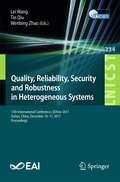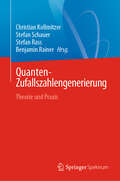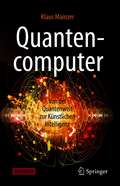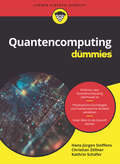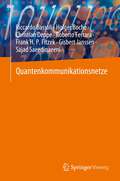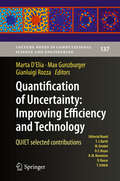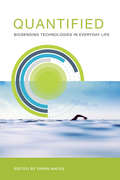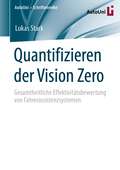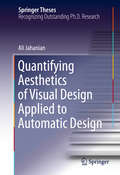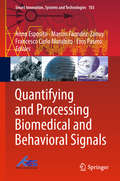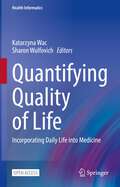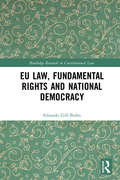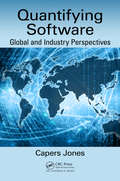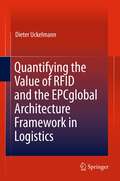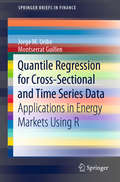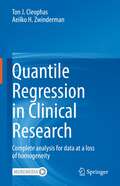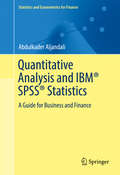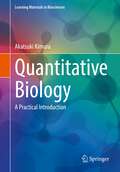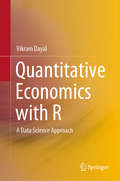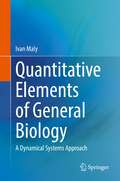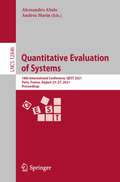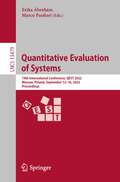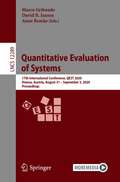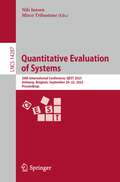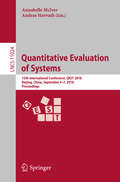- Table View
- List View
Quality, Reliability, Security and Robustness in Heterogeneous Systems: 13th International Conference, Qshine 2017, Dalian, China, December 16-17, 2017, Proceedings (Lecture Notes of the Institute for Computer Sciences, Social Informatics and Telecommunications Engineering #234)
by Wenbing Zhao Tie Qiu Lei WangThis book constitutes the refereed post-conference proceedings of the 13th International Conference on Quality, Reliability, Security and Robustness in Heterogeneous Networks, QShine 2017, held in Dalian, China, in December 2017. The 25 revised full papers were carefully reviewed and selected from 43 submissions. The papers are organized thematically in tracks, starting with mobile and wireless networks, quality and reliability, wireless networking algorithms and protocols, and smart applications.
Quanten-Zufallszahlengenerierung: Theorie und Praxis
by Stefan Rass Stefan Schauer Christian Kollmitzer Benjamin RainerDieses Buch bietet einen Überblick über die neuesten Implementierungen von Quanten-Zufallszahlengeneratoren (QRNGs) und untersucht insbesondere deren Beziehung zu klassischen statistischen Zufallsmodellen und numerischen Techniken zur Berechnung von Zufallszahlen. Der Leser - der idealerweise einen Hintergrund in klassischer Statistik, Informatik oder Kryptographie hat - wird Schritt für Schritt in die Welt der Quantenbits eingeführt, und es werden explizite Beziehungen zwischen QRNGs und ihren klassischen Gegenstücken aufgezeigt. Die Erzeugung von Zufallszahlen ist eine wichtige Säule der Kryptographie. Die Nutzung des Zufalls, der Quantenphänomenen innewohnt, ist ein sich rasch entwickelnder Zweig der Quantenkryptografie mit unzähligen Anwendungen für die Zukunft. Der Wert der Quantenzufälligkeit für kryptografische Zwecke wird empirisch durch statistische Auswertungen der Leistung von QRNGs im Vergleich zu klassischen Techniken zur Erzeugung echter und pseudozufälliger Zahlen nachgewiesen. Das Buch bietet dann einen Überblick über die technischen Implementierungen von QRNGs, bevor eine abschließende Diskussion über die wichtigsten Errungenschaften und verbleibenden Hindernisse auf diesem Gebiet die Berichterstattung abrundet und gleichzeitig die Tür für zukünftige Forschungsrichtungen öffnet.
Quantencomputer: Von der Quantenwelt zur Künstlichen Intelligenz
by Klaus MainzerDie Quantenwelt ist längst im Alltag angekommen, ohne dass es vielen bewusst ist. Dazu gehören Transistoren, Dioden und Laser, die aus Alltagsgeräten nicht mehr fortzudenken sind. Nach dieser ersten Generation der Quantentechnologien leben wir derzeit in der zweiten Generation, in der Grundprinzipien der Quantenmechanik gezielt in quantenmechanischen Geräten umgesetzt werden. Dazu gehören erste Prototypen von Quantencomputern, klassische Supercomputer mit Quantensimulation, Quantenkryptographie und Quantenkommunikation, Quantensensorik und Quantenmesstechnik. Was Einstein 1935 als spukhafter Effekt vorkam, ist längst Grundlage umwälzender Quantenkommunikation in Glasfasernetzen und Satellitentechnik, die ein zukünftiges Quanteninternet ankündigt. Quantencomputer als Mehrzweckrechner sind nur die Spitze des Eisbergs mit einer Technologie, die sich schrittweise als Netzwerk unserer Zivilisation ausbreitet. Umso dringender ist es, die Grundlagen der Quantenwelt als Hintergrund dieser Technologie zu verstehen. Grundlagen und Zusammenhänge begreifen, von den mathematischen und physikalischen Grundlagen bis zu den technischen Anwendungen, ist ein zentrales Ziel des Buchs. Ein weiteres Anliegen dieses Buchs ist das Zusammenwachsen mit der Künstlichen Intelligenz. In meinem Buch „Künstliche Intelligenz. Wann übernehmen die Maschinen?“ (Springer 2. Aufl. 2019) wird Machine learning herausgestellt, das Automatisierung in Robotik, Industrie- und Arbeitswelt verwirklicht. Mit Quantentechnologie, Quantencomputer und künstlicher Intelligenz zeichnet sich aber nicht nur eine Potenzierung neuer Möglichkeiten ab, sondern auch von Gefährdungen. Daher erhebt sich die Forderung nach frühzeitiger Technikgestaltung, damit Quantentechnologie und Künstliche Intelligenz sich als Dienstleistung in der Gesellschaft bewähren.
Quantencomputing für Dummies (Für Dummies)
by Hans-Jurgen Steffens Christian Zöllner Kathrin SchäferQuantencomputing könnte die Informatik wie wir sie heute kennen revolutionieren. Die Möglichkeiten dieser Technologie sind enorm. Aber was steckt eigentlich dahinter? Mit diesem Buch führen Sie die Autoren so verständlich wie möglich in dieses komplexe Thema ein. Sie erklären Ihnen was es mit dem Quantencomputing überhaupt auf sich hat und erläutern die mathematischen und physikalischen Modelle, die ihm zugrunde liegen. Sie vergleichen Quantencomputing mit der aktuellen Informatik und werfen einen Blick darauf welche Anwendungen dadurch schon bald und welche in der weiteren Zukunft denkbar sind.
Quantenkommunikationsnetze
by Riccardo Bassoli Holger Boche Christian Deppe Roberto Ferrara Frank H. Fitzek Gisbert Janssen Sajad SaeedinaeeniDieses Buch bietet ein Tutorial über Quantenkommunikationsnetze. Die Autoren erörtern aktuelle Paradigmenwechsel in Kommunikationsnetzen, die erforderlich sind, um die einfachen Transportkonzepte der vorherrschenden Netze um Rechen- und Speicherfunktionen zu ergänzen. Sie zeigen, wie diese "softwarisierten" Lösungen neue Wege beschreiten, um Latenzzeiten zu reduzieren und die Ausfallsicherheit zu erhöhen. Die Autoren erörtern, wie diese Lösungen trotz der ihnen innewohnenden Probleme aufgrund der eingeführten Rechenlatenz und des Energieverbrauchs durch hybride klassisch-quantische Kommunikationsnetze gelöst werden können. Das Buch bringt Quantennetzwerke, Quanteninformationstheorie, Quantencomputer und Quantensimulation zusammen.
Quantification of Uncertainty: QUIET selected contributions (Lecture Notes in Computational Science and Engineering #137)
by Marta D’Elia Max Gunzburger Gianluigi RozzaThis book explores four guiding themes – reduced order modelling, high dimensional problems, efficient algorithms, and applications – by reviewing recent algorithmic and mathematical advances and the development of new research directions for uncertainty quantification in the context of partial differential equations with random inputs. Highlighting the most promising approaches for (near-) future improvements in the way uncertainty quantification problems in the partial differential equation setting are solved, and gathering contributions by leading international experts, the book’s content will impact the scientific, engineering, financial, economic, environmental, social, and commercial sectors.
Quantified: Biosensing Technologies in Everyday Life
by Dawn NafusWhat is at stake socially, culturally, politically, and economically when we routinely use technology to gather information about our bodies and environments? Today anyone can purchase technology that can track, quantify, and measure the body and its environment. Wearable or portable sensors detect heart rates, glucose levels, steps taken, water quality, genomes, and microbiomes, and turn them into electronic data. Is this phenomenon empowering, or a new form of social control? Who volunteers to enumerate bodily experiences, and who is forced to do so? Who interprets the resulting data? How does all this affect the relationship between medical practice and self care, between scientific and lay knowledge? Quantified examines these and other issues that arise when biosensing technologies become part of everyday life.The book offers a range of perspectives, with views from the social sciences, cultural studies, journalism, industry, and the nonprofit world. The contributors consider data, personhood, and the urge to self-quantify; legal, commercial, and medical issues, including privacy, the outsourcing of medical advice, and self-tracking as a “paraclinical” practice; and technical concerns, including interoperability, sociotechnical calibration, alternative views of data, and new space for design.ContributorsMarc Böhlen, Geoffrey C. Bowker, Sophie Day, Anna de Paula Hanika, Deborah Estrin, Brittany Fiore-Gartland, Dana Greenfield, Judith Gregory, Mette Kragh-Furbo, Celia Lury, Adrian Mackenzie, Rajiv Mehta, Maggie Mort, Dawn Nafus, Gina Neff, Helen Nissenbaum, Heather Patterson, Celia Roberts, Jamie Sherman, Alex Taylor, Gary Wolf
Quantifizieren der Vision Zero: Gesamtheitliche Effektivitätsbewertung von Fahrerassistenzsystemen (AutoUni – Schriftenreihe #165)
by Lukas StarkModerne Fahrzeuge sind mit einer Vielzahl an elektronischen Systemen ausgestattet, die unter anderem dazu beitragen, die Verkehrssicherheit zu erhöhen. Die vorliegende Arbeit befasst sich mit der Untersuchung der Wirksamkeit von Fahrerassistenzsystemen und automatischen Fahrfunktionen hinsichtlich der Vermeidung von schweren Verkehrsunfällen. Die entwickelte gesamtheitliche Methodik zur Effektivitätsbewertung adressiert folgende Themenschwerpunkte: Bewertungsmethodik, Datengrundlage und Integration der zu bewertenden Systeme in die Bewertungsumgebung.
Quantifying Aesthetics of Visual Design Applied to Automatic Design
by Ali JahanianIn this thesis, the author makes several contributions to thestudy of design of graphical materials. The thesis begins with a review of therelationship between design and aesthetics, and the use of mathematical modelsto capture this relationship. Then, a novel method for linking linguistic concepts to colorsusing the Latent Dirichlet Allocation Dual Topic Model is proposed. Next, the thesis studies the relationship between aesthetics and spatial layout by formalizing the notion of visual balance. Applying principles of salience and Gaussian mixture models over a body of about 120,000 aesthetically rated professional photographs, the author provides confirmation of Arnhem's theory about spatial layout. The thesis concludes with a description oftools to support automatically generating personalized design.
Quantifying and Processing Biomedical and Behavioral Signals (Smart Innovation, Systems and Technologies #103)
by Anna Esposito Marcos Faundez-Zanuy Francesco Carlo Morabito Eros PaseroThe book is based on interdisciplinary research on various aspects and dynamics of human multimodal signal exchanges. It discusses realistic application scenarios where human interaction is the focus, in order toidentify new methods for data processing and data flow coordination through synchronization, and optimization of new encoding features combining contextually enacted communicative signals, anddevelop shared digital data repositories and annotation standards for benchmarking the algorithmic feasibility and successive implementation of believable human–computer interaction (HCI) systems.This book is a valuable resource for a. the research community, PhD students, early stage researchersc. schools, hospitals, and rehabilitation and assisted-living centerse. the ICT market, and representatives from multimedia industries
Quantifying Quality of Life: Incorporating Daily Life into Medicine (Health Informatics)
by Katarzyna Wac Sharon WulfovichThis open access book presents the rise of technology-enabled methods and tools for objective, quantitative assessment of Quality of Life (QoL), while following the WHOQOL model. It is an in-depth resource describing and examining state-of-the-art, minimally obtrusive, ubiquitous technologies. Highlighting the required factors for adoption and scaling of technology-enabled methods and tools for QoL assessment, it also describes how these technologies can be leveraged for behavior change, disease prevention, health management and long-term QoL enhancement in populations at large. Quantifying Quality of Life: Incorporating Daily Life into Medicine fills a gap in the field of QoL by providing assessment methods, techniques and tools. These assessments differ from the current methods that are now mostly infrequent, subjective, qualitative, memory-based, context-poor and sparse. Therefore, it is an ideal resource for physicians, physicians in training, software and hardware developers, computer scientists, data scientists, behavioural scientists, entrepreneurs, healthcare leaders and administrators who are seeking an up-to-date resource on this subject.
Quantifying Software: Global and Industry Perspectives (Routledge Research In Constitutional Law Ser.)
by Capers JonesSoftware is one of the most important products in human history and is widely used by all industries and all countries. It is also one of the most expensive and labor-intensive products in human history. Software also has very poor quality that has caused many major disasters and wasted many millions of dollars. Software is also the target of frequent and increasingly serious cyber-attacks. <P><P>Among the reasons for these software problems is a chronic lack of reliable quantified data. This reference provides quantified data from many countries and many industries based on about 26,000 projects developed using a variety of methodologies and team experience levels. The data has been gathered between 1970 and 2017, so interesting historical trends are available. <P><P>Since current average software productivity and quality results are suboptimal, this book focuses on "best in class" results and shows not only quantified quality and productivity data from best-in-class organizations, but also the technology stacks used to achieve best-in-class results. The overall goal of this book is to encourage the adoption of best-in-class software metrics and best-in-class technology stacks. It does so by providing current data on average software schedules, effort, costs, and quality for several industries and countries. <P><P>Because productivity and quality vary by technology and size, the book presents quantitative results for applications between 100 function points and 100,000 function points. It shows quality results using defect potential and DRE metrics because the number one cost driver for software is finding and fixing bugs. The book presents data on cost of quality for software projects and discusses technical debt, but that metric is not standardized. Finally, the book includes some data on three years of software maintenance and enhancements as well as some data on total cost of ownership.
Quantifying Software: Global and Industry Perspectives (Routledge Research In Constitutional Law Ser.)
by Capers JonesSoftware is one of the most important products in human history and is widely used by all industries and all countries. It is also one of the most expensive and labor-intensive products in human history. Software also has very poor quality that has caused many major disasters and wasted many millions of dollars. Software is also the target of frequent and increasingly serious cyber-attacks. Among the reasons for these software problems is a chronic lack of reliable quantified data. This reference provides quantified data from many countries and many industries based on about 26,000 projects developed using a variety of methodologies and team experience levels. The data has been gathered between 1970 and 2017, so interesting historical trends are available. Since current average software productivity and quality results are suboptimal, this book focuses on "best in class" results and shows not only quantified quality and productivity data from best-in-class organizations, but also the technology stacks used to achieve best-in-class results. The overall goal of this book is to encourage the adoption of best-in-class software metrics and best-in-class technology stacks. It does so by providing current data on average software schedules, effort, costs, and quality for several industries and countries. Because productivity and quality vary by technology and size, the book presents quantitative results for applications between 100 function points and 100,000 function points. It shows quality results using defect potential and DRE metrics because the number one cost driver for software is finding and fixing bugs. The book presents data on cost of quality for software projects and discusses technical debt, but that metric is not standardized. Finally, the book includes some data on three years of software maintenance and enhancements as well as some data on total cost of ownership.
Quantifying the Value of RFID and the EPCglobal Architecture Framework in Logistics
by Dieter UckelmannThe "EPCglobal Architecture Framework" is currently the most accepted technical approach to the Internet of Things and provides a solid foundation for building Business-to-Business information networks based on unique identifications of 'things'. Lately, the vision of the Internet of Things has been extended to a more holistic approach that integrates sensors as well as actuators and includes non-business stakeholders. A detailed look at the current state of the art in research concerning cost and benefit estimations is provided and the limits of Cost Benefit Sharing for RFID-based IT-infrastructures are explained. In this work a market driven evaluation based on sales potential of information is developed. Simple technical means for aggregation of micro values to a billable amount are discussed. The requirements for electronic billing infrastructure are defined and a matching e-billing solutions for an evaluation scenario is presented, providing a technical infrastructure to evaluate and bill product-related information in a future Internet of Things, based on an extended EPCglobal Architecture. Further opportunities and threats are discussed to provide an overview of its future potential. As a result it will contribute to the sustainable success of the Internet of Things itself.
Quantile Regression for Cross-Sectional and Time Series Data: Applications in Energy Markets Using R (SpringerBriefs in Finance)
by Jorge M. Uribe Montserrat GuillenThis brief addresses the estimation of quantile regression models from a practical perspective, which will support researchers who need to use conditional quantile regression to measure economic relationships among a set of variables. It will also benefit students using the methodology for the first time, and practitioners at private or public organizations who are interested in modeling different fragments of the conditional distribution of a given variable. The book pursues a practical approach with reference to energy markets, helping readers learn the main features of the technique more quickly. Emphasis is placed on the implementation details and the correct interpretation of the quantile regression coefficients rather than on the technicalities of the method, unlike the approach used in the majority of the literature. All applications are illustrated with R.
Quantile Regression in Clinical Research: Complete analysis for data at a loss of homogeneity
by Aeilko H. Zwinderman Ton J. CleophasQuantile regression is an approach to data at a loss of homogeneity, for example (1) data with outliers, (2) skewed data like corona - deaths data, (3) data with inconstant variability, (4) big data. In clinical research many examples can be given like circadian phenomena, and diseases where spreading may be dependent on subsets with frailty, low weight, low hygiene, and many forms of lack of healthiness. Stratified analyses is the laborious and rather explorative way of analysis, but quantile analysis is a more fruitful, faster and completer alternative for the purpose. Considering all of this, we are on the verge of a revolution in data analysis. The current edition is the first textbook and tutorial of quantile regressions for medical and healthcare students as well as recollection/update bench, and help desk for professionals. Each chapter can be studied as a standalone and covers one of the many fields in the fast growing world of quantile regressions. Step by step analyses of over 20 data files stored at extras.springer.com are included for self-assessment. We should add that the authors are well qualified in their field. Professor Zwinderman is past-president of the International Society of Biostatistics (2012-2015) and Professor Cleophas is past-president of the American College of Angiology(2000-2002). From their expertise they should be able to make adequate selections of modern quantile regression methods for the benefit of physicians, students, and investigators.
Quantitative Analysis and IBM® SPSS® Statistics
by Abdulkader AljandaliThis guide for practicing statisticians and data scientists who use IBM SPSS for statistical analysis of big data in business and finance is the first of a two-part guide to SPSS for Windows, introducing data entry into SPSS, along with elementary statistical and graphical methods for summarizing and presenting data. Part I also covers the rudiments of hypothesis testing and business forecasting while Part II will present multivariate statistical methods, more advanced forecasting methods, and multivariate methods. IBM SPSS offers a powerful set of statistical and information analysis systems that run on a wide variety of personal computers. The Windows version of SPSS is built around routines that have been developed, tested, and widely used for more than 20 years. As such, SPSS is extensively used in industry, commerce, banking, local and national governments, and education. Just a small subset of users of the package include the major clearing banks, the BBC, British Gas, British Airways, British Telecom, the Consumer Association, Eurotunnel, Glaxo, ICI, London Underground, the NHS, Plessey, Shell, Unilever, and W. H. Smith and Son. Although the emphasis in this guide is on applications of SPSS for Windows, there is a need for users to be aware of the statistical assumptions and rationales underpinning correct and meaningful application of the techniques available in the packa≥ therefore, such assumptions are discussed, and methods of assessing their validity are described. Also presented is the logic underlying the computation of the more commonly used test statistics in the area of hypothesis testing. Mathematical background is kept to a minimum.
Quantitative Biology: A Practical Introduction (Learning Materials in Biosciences)
by Akatsuki KimuraThis textbook is for biologists, to conduct quantitative analysis and modeling of biological processes at molecular and cellular levels. Focusing on practical concepts and techniques for everyday research, this text will enable beginners, both students and established biologists, to take the first step in quantitative biology. It also provides step-by-step tutorials to run various sample programs in one’s personal computer using Excel and Python. This volume traces topics, starting with an introductory chapter, such as modeling, construction and execution of numerical models, and key concepts in quantitative biology: feedback regulations, fluctuations and randomness, and statistical analyses. It also provide sample codes with guidance to procedure programming for actual biological processes such as movement of the nucleus within a cell, cell-cycle regulation, stripe pattern formation of skins, and distribution of energy. Written by a leading research scientist who has a background in biology, studied quantitative approaches by himself, and teaches quantitative biology at several universities, this textbook broadens quantitative approaches for biologists who do not have a strong background in mathematics, physics, or computer programming, and helps them progress further in their research.
Quantitative Economics with R: A Data Science Approach
by Vikram DayalThis book provides a contemporary treatment of quantitative economics, with a focus on data science. The book introduces the reader to R and RStudio, and uses expert Hadley Wickham’s tidyverse package for different parts of the data analysis workflow. After a gentle introduction to R code, the reader’s R skills are gradually honed, with the help of “your turn” exercises. At the heart of data science is data, and the book equips the reader to import and wrangle data, (including network data). Very early on, the reader will begin using the popular ggplot2 package for visualizing data, even making basic maps. The use of R in understanding functions, simulating difference equations, and carrying out matrix operations is also covered. The book uses Monte Carlo simulation to understand probability and statistical inference, and the bootstrap is introduced. Causal inference is illuminated using simulation, data graphs, and R code for applications with real economic examples, covering experiments, matching, regression discontinuity, difference-in-difference, and instrumental variables. The interplay of growth related data and models is presented, before the book introduces the reader to time series data analysis with graphs, simulation, and examples. Lastly, two computationally intensive methods—generalized additive models and random forests (an important and versatile machine learning method)—are introduced intuitively with applications. The book will be of great interest to economists—students, teachers, and researchers alike—who want to learn R. It will help economics students gain an intuitive appreciation of applied economics and enjoy engaging with the material actively, while also equipping them with key data science skills.
Quantitative Elements of General Biology: A Dynamical Systems Approach
by Ivan MalyThis monograph sketches out a broad spectrum of problems (from evolution and metabolism to morphogenesis and biogeographical dynamics) whose solution has been impacted by mathematical models. Each of the selected examples has led to the recognition—and set direction to further study—of certain fundamental but unintuitive properties of biological systems, such as the making and breaking of specific symmetries that underlie morphogenesis. Whether they are long-established or only recently accepted, these models are selected for being thought-provoking and illuminating both the achievements and the gaps in our current understanding of the given area of biology. The selection of models is also meant to bring to the fore the existing degree of unity in the quantitative approach to diverse general-biological questions and in the systems-level properties that are discovered across the levels of biological organization. It is the thesis of this book that further cultivation of such unity is a way forward as we progress toward a general theory of living matter.This is an ideal book for students (in the broadest sense) of biology who wish to learn from this attempt to present the exemplary models, their methodological lessons, and the outline of a unified theory of living matter that is now beginning to emerge. In addition to a doctoral student preparing for quantitative biology research, this reader could also be an interdisciplinary scientist transitioning to biology. The latter—for example, a physicist or an engineer—may be comfortable with the mathematical apparatus and prepared to quickly enter the intended area of work, but desires a broader foundation in biology from the quantitative perspective.
Quantitative Evaluation of Systems: 18th International Conference, QEST 2021, Paris, France, August 23–27, 2021, Proceedings (Lecture Notes in Computer Science #12846)
by Alessandro Abate Andrea MarinThis book constitutes the proceedings of the 18th International Conference on Quantitative Evaluation Systems, QEST 2021, held in Paris, France, in August 2021.The 21 full papers and 2 short papers presented together with 2 keynote papers were carefully reviewed and selected from 47 submissions. The papers are organized in the following topics: probabilistic model checking; quantitative models and metamodels: analysis and validation; queueing systems; learning and verification; simulation; performance evaluation; abstractions and aggregations; and stochastic models.
Quantitative Evaluation of Systems: 19th International Conference, QEST 2022, Warsaw, Poland, September 12–16, 2022, Proceedings (Lecture Notes in Computer Science #13479)
by Erika Ábrahám Marco PaolieriThis book constitutes the proceedings of the 19th International Conference on Quantitative Evaluation Systems, QEST 2022, held in Warsaw, Poland, in September 2022.The 19 full papers presented together with 1 keynote paper were carefully reviewed and selected from 44 submissions. The papers are organized in the following topics: program analysis; parameter synthesis; markovian agents and population models; dynamical systems; tools; applications and automata theory; and applications.
Quantitative Evaluation of Systems: 17th International Conference, QEST 2020, Vienna, Austria, August 31 – September 3, 2020, Proceedings (Lecture Notes in Computer Science #12289)
by Marco Gribaudo Anne Remke David N. JansenThis book constitutes the proceedings of the 17th International Conference on Quantitative Evaluation Systems, QEST 2020, held in Vienna, Austria, in August/September 2020. The 12 full papers presented together with 7 short papers were carefully reviewed and selected from 42 submissions. The papers cover topics such as classic measures involving performance and reliability, quantification of properties that are classically qualitative, such as safety, correctness, and security as well as analytic studies, diversity in the model formalisms and methodologies employed, and development of new formalisms and methodologies.
Quantitative Evaluation of Systems: 20th International Conference, QEST 2023, Antwerp, Belgium, September 20–22, 2023, Proceedings (Lecture Notes in Computer Science #14287)
by Nils Jansen Mirco TribastoneThis book constitutes the proceedings of the 20th International Conference on Quantitative Evaluation of Systems, QEST 2023, which took place in Antwerp, Belgium, in September 2023. The 23 papers included in this book were carefully reviewed and selected from 44 submissions. They deal with current topics in quantitative evaluation and verification of computer systems and networks, focusing on data-driven and machine-learning systems, case studies, and tool papers. The book also contains the extended abstract of the invited talk from David Parker.
Quantitative Evaluation of Systems: 15th International Conference, QEST 2018, Beijing, China, September 4-7, 2018, Proceedings (Lecture Notes in Computer Science #11024)
by Annabelle McIver Andras HorvathThis book constitutes the proceedings of the 15th International Conference on Quantitative Evaluation Systems, QEST 2018, held in Beijing, China, in September 2018. The 24 full papers presented were carefully reviewed and selected from 51 submissions. The papers cover topics in the field of quantitative evaluation and verification of computer systems and networks through stochastic models and measurements emphasizing two frontier topics in research: quantitative information flow for security and industrial formal methods.
